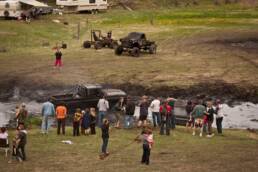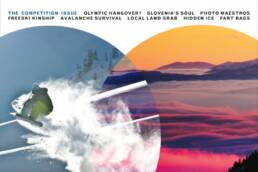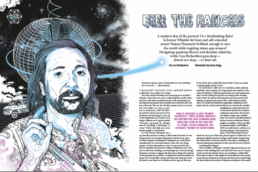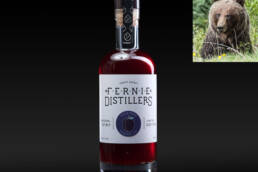The redneck-versus-hippie debate defines these heady days of mountain culture. To kill or to save? Writer Raymond Schmidt lives in the cultural mountain melting pot of Canmore, Alberta, on the fence between the hunters and the hunted, and he asks: are rednecks the true saviours of the land?
Lemongrass and swiss chard. You find more of it in the produce aisles of many a British Columbian town these days. You can thank rural gentrification and a nouveau-green sensibility for that. This shift to a more cosmopolitan cuisine is a result of a cultural change on the landscape that could be attributed to a reduction in the overall health of our wilderness: more of us want the perfect life, but less of us are willing to get dirty for it. Thankfully, there’s an enduring, if not maligned member of British Columbia’s underbelly, sandwiched between rich acreages and rural landscapes, that’s actively trying to maintain an ecological balance. The redneck – despite their penchant for the combustion engine – is the true foot soldier of environmental management.
As a dedicated recreationalist, I always felt my kin were the true stewards of the wilderness. We “actively” managed landscape simply by leaving it alone or at the very least, treading lightly on it. During those soft walks and gentle rides, we convinced ourselves we were doing the right thing by only taking pictures and leaving footprints. I despised piston heads for their belching Hemis and for ghost riding the old Chevy off the cliff. To me, true wilderness was a landscape that included abundant wildlife, a stratum of plant species and rich aquatic systems. People didn’t belong, and if they did, it better be by non-motorized means – protected spaces shaded in green on maps reinforced this in me. But maybe wilderness, like Golden’s orphaned grizzly bear, is not meant to be caged in an enclosure.

“Humans are a part of, rather than apart from the natural world,” says Stowe, with his heartwarming hick talk.
I’ve been feeling a sense of environmental disillusionment lately. The jet-setting evangelism of Al Gore types about reducing carbon footprints, while not actually doing it, is hypocritical, and “sustainable” developers convincing us that golf courses are good pathways for wildlife is frustrating; it has me looking for a different paradigm in long-term wilderness management. That’s when I met Johnny Stowe. He has written dozens of articles defending the positive utilitarian value of the redneck on the land. Today, Stowe is a wildlife biologist who works with South Carolina’s Department of Natural Resources. I’d always avoided calling them rednecks to their face, but I learned Stowe is good with it. “I lived in the woods for 10 years. I’m not a scientist. I’m a redneck,” he declares.
“Humans are a part of, rather than apart from the natural world,” says Stowe, with his heartwarming hick talk. Okay, the old beer fridge in the ditch and the car-fluvial fan that flows into Invermere’s “pristine” Toby Creek aren’t exactly resume builders, but these are stereotypical – albeit witnessed – portrayals of a culture group. There are, of course, some parts of nature that still need to be untouched. People are part of the landscape, yes, but we shouldn’t be the dominant species on every square foot of the land. There still need to be wilderness areas without people. Right? It’s not a God-given right to go everywhere, and fossil fuels aren’t part of that natural balance. Or are they? Stowe agrees a lot of motorized access is unnecessary and destructive. “There are exceptions with every group,” he explains, referencing the pit-partying rednecks who like to burn their trucks. “You get into nuance when you talk about the redneck. But if you have 10,000 people playing bridge, somebody’s going to cheat.”
Nuance acknowledged, there are also plenty of rednecks in British Columbia who are proud of their culture. “Yeah, I would say I’m a redneck,” says Fernie’s Kevin Marasco. The town’s Rod and Gun Club president has earned his stripes by popping caps into elk since he was 11 years old. What characterizes his redneckness? “We know wildlife,” he states. “And we’re living it. We’re not just taking spreadsheet data; we’re going into those areas. Biologists ask us what we see out there.”
It sounds like such a simple concept: just be there. But it’s as if we’re taught the opposite, that anything is most understood and best undertaken by those with decades of schooling. But experience, which is to say “being there,” is the thing. While academics are taking Crossfit lunch breaks, Marasco is out there on the land – and has been for 40 years. With that kind of continuity, he and his brethren are witnessing and managing rich landscapes with the data written on the trees and animals. Maybe when it’s putting supper in your belly rather than putting letters beside your signature, you just have a richer vested interest in paying attention to the nuances of nature.
There’s no wildlife issues with rednecks. Rural people just shoot the damn thing. – Johnny Stowe, U.S. writer and wildlife biologist
For a good ol’ southern redneck like Johnny Stowe, the critters he’s paying attention to might be possums, coons and polecats, but the one we have in common throughout North America is the white-tailed deer. They may not be a problem in South Carolina where Stowe shot, gutted and ate 25 deer last year, but overabundance of the species is becoming a problem in British Columbia.
Deer aren’t just a problem because they’re eating people’s garden chives or flopping onto Prius windshields. They’re also overeating important local habitat, not to mention hiding safely in neighbourhoods where natural predators are loath to go. In 2010, the Globe and Mail reported that Grand Forks is struggling with its blooming deer population. “This has become a topic that is really difficult for elected officials to manage,” Mayor Brian Taylor was quoted as saying. “We have incidents where a deer has been running around with five arrows sticking out of him.” There also seems to be an arrow pointing directly at the solution to the deer problem, but a straightshooting politician can’t face it. Okay, a crooked-shooting redneck might have had one too many Lucky Lagers, but for Grand Forks, at least, the arrows are a good sign there’s still somebody willing to solve the problem. “There’s no wildlife issues with rednecks,” explains Stowe. “Rural people just shoot the damn thing.”
The flipside is a community that can’t bear the thought of killing. Kimberley must have had a Tilley hat council; they wanted the province to put the deer on birth control. Once a tough mining town, it appears they followed in the effeminate footsteps of the genteel ex-mining town of Canmore that’s got a feral bunny problem it just can’t solve.
Birth control? Kimberley has since axed plans for the pill and is now exploring the redneck route of a restricted hunt on Cityowned land. Beyond population control, it’s about feeding the community with some fresh, lean and local organic venison. That’s what rednecks do. “We share a lot of our meat,” says Marasco, who himself bags about three elk a year, feeding friends and his family a few days a week on it. Johnny Stowe – surprise, surprise – would agree. “Ecologists will say, ‘[Deer] shouldn’t be here,’” explains Stowe. “But they won’t say, ‘We need to kill the hell out of them!’” And they certainly, Stowe suggests, wouldn’t be the ones to take on the task. “But if you go out back and ask the redneck if he’ll help remove the deer, he’ll say, ‘Hell yeah! Can I bring my son?’”
As British Columbia continues to experience landscape fragmentation and increased “rurbanism,” the redneck’s ability to freely manage the land continues to fade. Marasco is fighting that change by teaching his kids and those in the community the redneck way through hunting, fishing and active participation. It’s nice to live in a piece of wilderness, but as you split a deer in half with your Range Rover on your way to renewing your Greenpeace membership, just remember that an increase in the population of rednecks – the doers of environmental management – could have saved you the hassle of repairing your vehicle, and it would have given them a hell of a lot of fun and fresh meat in the meantime.
Raymond Schmidt
Although he has gutted a moose, burned a forest and owned a truck, Raymond Schmidt is not a redneck (we think) but a freelance writer from Canmore, Alberta.
Related Stories
Octogenarians Love us Too!
Here's some great feedback from a longtime reader. Sure, she's part of the family (our Managing Editor's Grandmother),…
Eddie Hunter Shares His Love of Banff National Park and Mt. Norquay
This is an absolutely beautiful story...in an absolutely stunning place.
Fernie Bears Love This Gin…But Not For The Reason You Might Think
Fernie Distillers has launched their first limited release seasonal product called 5th & Park Damson Gin made with…
Enter The Love Triangle – Is It Time For An A-Frame Resurgence?
A-frames were born from utilitarian roots, then embraced throughout the 1960s and 70s by holiday home builders in…








